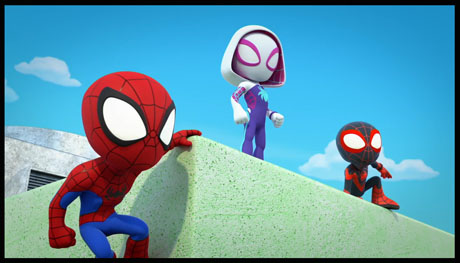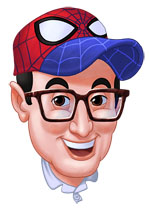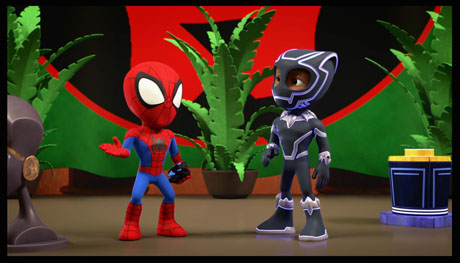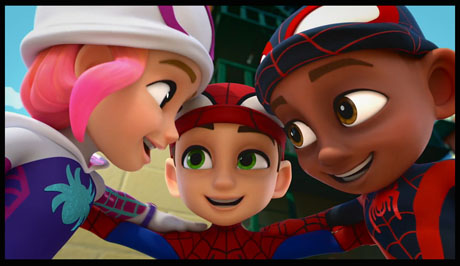
Animated superhero show staple Harrison Wilcox (Ultimate Spider-Man, Avengers Assemble) is now the executive producer of Marvel’s Spidey and his Amazing Friends. Its one-hour premiere is this Friday August 6th at 9am on Disney Junior. Wilcox takes me inside the complex but fun production web of his first CG series.
Jackson Murphy: Early on in the first episode, we get a sense of Peter, Miles and Gwen as kids. They’re not just superheroes but they’re [also] fun kids enjoying ice cream. How was that balance for you in trying to make these characters come alive in this series – to balance them as superheroes and as fun kids?
Harrison Wilcox: It was a lot of fun for me because I’m a lifelong Marvel fan and have read and also worked on a number of Spider-Man projects over the years. When this one came along, I happened to have preschoolers of my own at home, so it was a special opportunity and a fun chance to get to tell stories about fun characters that I love directly for kids [who are] the ages of my own.

JM: I bet, because I was thinking: most of the MCU movies are PG-13 and some of the Marvel movies are rated R… what that opportunity feels like for you to give young kids, like the ones you have, the chance to see and have fun with these characters. Did you really feel that opportunity as you were making this?
HW: Yeah, that’s why I took the job in the first place at Marvel – to do what had been done for me as a kid. I grew-up on ’90s X-Men. It’s always been about bringing-in the next generation of Marvel fans – the younger audiences who might not yet be exposed to comics or the movies. And hopefully they’ll fall in love with these characters on these series and when they get older will find that other content.

Harrison Wilcox
HW: It’s always hard with Spider-Man and Avengers characters because there’s so many great ones to choose from. Having been a fan as long as I have, it was hard to narrow it down to just a few. But we really wanted to pick just a few so that our young audience can really get a chance to get to know these characters. We tried to pick both guest heroes and the three villains based on personality and power sense, so that they would have a good variety to the group. We looked at our villains and wanted to have them each have a different motivation. For example, we wanted Doc Ock to be someone who was trying to rule. Rhino’s someone who wants to take things. And Goblin likes to ruin other people’s fun. Rule, ruin and take were the things we were looking for – very simple motivations for this audience – and we found them with those three characters.
JM: Good. And obviously a lot of lessons kids can learn from everything. In the first Black Panther episode, there’s a theme of having patience. When did you sort of feel that while making this first season of this show?
HW: (laughs) We looked at simple, relatable storytelling, which is what Disney Junior is known for and does so well. We learned a lot from them about how young audiences respond to storytelling. It was a lot of fun having them be our guide into this world of preschool while we were, in turn, sort of their guides for the Marvel universe. It was an interesting process early on to meld these two entities together.
JM: Yeah, kind of a symbiotic relationship. And which of these characters was the most difficult for you to make sure you get right and treat well? To make that character’s legacy still be excellent?

HW: It wasn’t difficult in necessarily that way but it was interesting working on stories about Black Panther because I had done another series called Black Panther’s Quest. So I know and love so many things about Black Panther, and he has so many things that are so cool about him. The difficulty, for preschool storytelling, was to pick one thing at a time that was so cool about him. We picked vibranium, for example, and tried to explain that in very straightforward, relatable terms to preschoolers – what vibranium is, why it’s special, how that makes Black Panther special. That was the hardest aspect of the three guest heroes and the three villains – not resisting the urge to throw all the cool things we know about Black Panther at the audience at once but instead parse them out over the course of the season.
JM: That makes sense. You wanna spread them out over a bunch of episodes for kids to experience a little bit here and there. And certainly the Black Panther movie had an impact on so many, obviously with the late Chadwick Boseman. Is there a superhero movie cinematic experience from your life that has always stood out to you? And I love that in [the episode] “Lost and Found”, we get a little trip to the movies.
HW: That’s a really good question. It’s not a superhero movie, but I always go back to The Goonies. It’s about kids and it’s fantastical but there are real stakes. I think young audiences appreciate real stakes. And I think that’s something that’s unique and special about this preschool show. It is the world of Marvel. It is the world of Spidey. There are stakes. There are villains to stop and consequences if they don’t.
JM: There is legitimate danger. These heroes have to do their jobs to save everybody. The cityscape is so bright. There are also so many buildings and windows. In terms of the animation, is that a challenge to do all the buildings and the many, many windows, or is there a program in your software that can help speed up that process?

HW: It was an interesting learning opportunity. This is my first CG show. You can build all those things, but if you wanna go inside, you obviously have to build that room. You don’t just draw a background. You actually have to build the indoor space. We have a bunch of dedicated indoor spaces that we try to go back to – the inside of the museum, for example, the inside of the aquarium. If we need to go inside a pizza parlor, we will build that for the episode. But like the backlot of a movie studio, some of those buildings are just facades until you need them to be an actual scene and location.
JM: What surprised you the most with this being your first CG show? Anything different with how you work with the characters?
HW: You can be a lot more dynamic with camerawork and… that really lends itself to characters who move and jump and swing and spin like our three Spider characters. You really feel the motion as they move through the city, similarly to the final scene in that first Sam Raimi Spider-Man movie where he’s leaping across the rooftops. You really get that sense of fluidity and motion with CG that you can’t always get with 2D animation.
JM: The spins on this show are cool. I also think these characters are bound to do well as toys. The way they look – they could fly off the shelves. You even mention the Black Panther cat toy in the first episode. Have you had involvement in the Marvel merch when it comes to the shows you’ve worked on and specifically this show?
HW: My primary focus is the creative on the series, but this is also probably the first show that I have been in communication with the consumer products folks. Everyone is trying so hard to be as close to the show as possible with the consumer products line. They all recognize how fantastic the show is for this audience, and they want to mirror that in their products.
JM: Good. What do you think, overall, is the most super thing that you have discovered and experienced about making this series so far?
HW: That it’s really a perfect fit for Spidey. He is the original kids superhero. If you look back at where he started in the comics, it was a world of fun adventures and wonder. And that’s what we’ve accomplished on this show. And it’s been a real treat as a lifelong Marvel fan to see that sort of storytelling take off in animation.
- INTERVIEW: “Inside Out 2” Director And Producer On Pixar Sequel - April 16, 2024
- INTERVIEW: “Puffin Rock And The New Friends” And 25 Years Of Cartoon Saloon - April 10, 2024
- INTERVIEW: “Chicken For Linda!” Directors On Annecy Winning Feature - April 9, 2024


 August 3rd, 2021
August 3rd, 2021  Jackson Murphy
Jackson Murphy  Posted in
Posted in  Tags:
Tags: 






